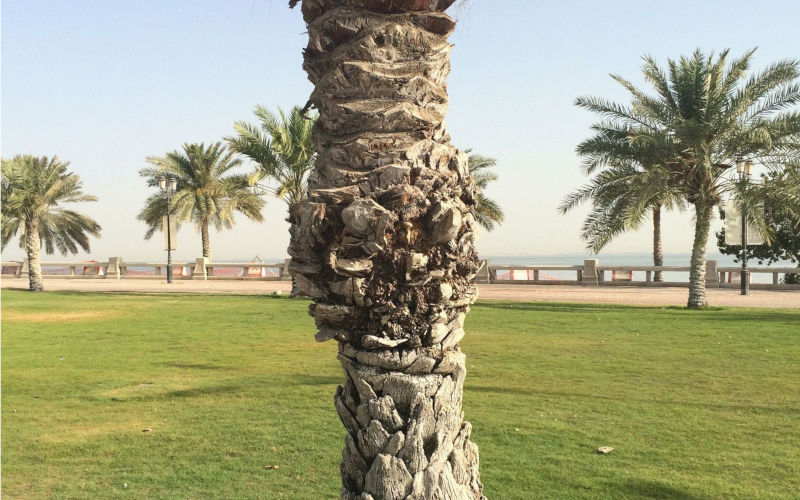Deformation of the Date Palm tree trunk in Dammam Metropolitan Area: causes and consequences
DOI:
https://doi.org/10.3097/LO.201965Keywords:
Date Palm (Phoenix dactylifera L.), Trunks deformation, Dammam Metropolitan Area, Landscaping, ornamental treeAbstract
Date palm (Phoenix dactylifera) is one of the elegant trees that performs several landscaping functions. Its single trunk textured by bases of the cut leaves distinguishes it from other ornamental trees. This cylindrical textured trunk is one of the major attractive features emphasized the use of date palms as ornamental landscaping trees. Across the Kingdom of Saudi Arabia, Date palms in public landscaping schemes have experienced deformation of their trunks. This is a function of several factors related to plantation, irrigation, and maintenance. This research to investigate and categorise the causes, types, and forms of date palm trees‘ trunks deformation. Prior to a field survey, a randomly conducted pilot survey to collect data from different areas where date palms are used as landscaping ornamental trees across the Dammam Metropolitan Area (DMA). It applies direct observation, measuring and analysis to develop preliminary understanding of the phenomena; and apply its outcomes on a case study of the Dammam City Seafront (DCS). The result showed that date palm trees‘ trunks deformation has occurred at bottom, middle, and upper parts as results of several factors; and it is as high as almost 97% among investigated trees. However, 58% of deformation symptoms processes have been noticed on bottom third of the date palm trees‘ trunks, near soil surface; and 27.5% of them are in the King Abdullah Seafront Park (KASP). The study proves statistically that sprinkler and bubbler irrigation systems are of major responsibility for near ground deformation of palm trees‘ trunks, which expands at rate of 3.5 and 3.3 CM/Year.
References
Albaker, A. (2002). Date Palm - Past and Present,
Al-Dosary, H. (2016). Caring Date Palms,
Al-Khashman, O. A., Al-Muhtaseb, A. H., & Ibrahim, K. A. (2011). Date palm (phoenix dactylifera L.) leaves as biomonitors of atmospheric metal pollution in arid and semi-arid environments. Environmental Pollution, 159(6), 1635-1640. doi:10.1016/j.envpol.2011.02.045
Al-Mana, F. A., & Ahmad, Y. A. (2010). Case study on the trunk's deformity of date palm trees used in street landscape in riyadh, saudi arabia. Am-Eurasian J.Agric.Environ.Sci., 8(1), 67-72.
Al-Shayeb, S. M., Al-Rajhi, M. A., & Seaward, M. R. D. (1995). The date palm (phoenix dactylifera L.) as a biomonitor of lead and other elements in arid environments. Science of the Total Environment, 168(1), 1-10. doi:10.1016/0048-9697(95)04556-G
Al-Wehaibi, M. (2008). Date Palm Biology,
Barreveld, W. H. (1993). Date Palm Products,
Broschat, T. (2017). Transplanting Palms in the Landscape,
Broschat, T. K. (1991). Effects of leaf removal on survival of transplanted sabal palms. J.Arboriculture, 17(2), 32-33.
Broschat, T. K. (1998). Root and shoot growth patterns in four palm species and their relationships with air and soil temperatures. HortScience, 33(6), 995-998. doi:10.21273/hortsci.33.6.995
Broschat, T. K., & Donselman, H. (1990). Regeneration of severed roots in washingtonia robusta and phoenix reclinata. Principes, 34(2), 96-97.
Broschat, T. K., & Donselman, H. (1984). Root regeneration in transplanted palms. Principes, 28, 90-91.
Chao, C. T., & Krueger, R. R. (2007). The date palm (phoenix dactylifera L.): Overview of biology, uses, and cultivation. HortScience, 42(5), 1077-1082. doi:10.21273/hortsci.42.5.1077
Costonis, A. C. (1995). Factors affecting survival of transplanted sabal palms. J.Arboricult., 21, 98-102.
El-Meleigi, M. A., Al-Rokibah, A. A., Hassan, Z. M., & Ibrahim, G. H. (1993). Vascular wilt of the date palm (phoenix dactylifera L.) casued by fusarium oxysporum in al-gassim region, central saudi arabia. Proceeding of the Third Symposium on the Date Palm in Saudi Arabia, 2, 67-76.
Hodel, D. R., Downer, A. J., Pittenger, D. R., & Beaudoin, P. J. (2006). Effect of amended backfill soils when planting five species of palms. HortTechnology, 16(3), 457-460. doi:10.21273/horttech.16.3.0457
Maki, M., Hamuda, A., & Al-Arabi, A. (1998). Pomology of Horticulture: Date Palms, 2
Moore Jr., H. E. (1963). An annotated checklist of cultivated palms. Principes, 7(4), 119-182.
Rashed, M. F., & Abdel El-Hafeez, N. E. (2001). Decline of date palm trees in egypt. Second International Conference on Date Palms, , 401-407.
Richardson-Calfee, L. E., & Harris, J. R. (2005). A review of the effects of transplant timing on landscape establishment of field-grown deciduous trees in temperate climates. HortTechnology, 15(1), 132-135. doi:10.21273/horttech.15.1.0132
Ricks, G. (1992). Landscape Plant Manual for Saudi Arabia,
Robinson, M., & Williams, C. (2016). The Date Palm Southern Nevada,
Sayan, M. S. (2001). Landscaping with palms in the mediterranean. Palms, 45(4), 171-176.
Simon, H. (1978). The Date Palm Bread of the Desert, , 50-60.
Zaid, A., & de Wet, P. (2016). Date Palm Cultivation-Chapter 1: Botanical Systematic Description of Date Palm,

Downloads
Published
How to Cite
Issue
Section
License
Copyright (c) 2019 Ali Omar Al-Sulbi

This work is licensed under a Creative Commons Attribution 4.0 International License.










